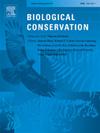Tracing seven decades of Chinese wildlife legislation from 1950 to the COVID-19 pandemic era
IF 4.9
1区 环境科学与生态学
Q1 BIODIVERSITY CONSERVATION
引用次数: 0
Abstract
Due to its abundant biodiversity and active wildlife trade, China's wildlife governance has been in the spotlight, especially following the legislative reforms introduced after the COVID-19 pandemic, hailed as “a turning point for China's wildlife protection”. Using Kingdon's framework, we analysed China's evolution of wildlife legislation from 1949 to 2023, focusing on species protected under the Wildlife Protection Law, encompassing mammals, amphibians, reptiles, birds, fish and insects. We examined the key drivers behind critical changes in China's approach to wildlife governance, the nature of these legislative changes, and their subsequent impacts.
The analysis identifies and describes three historical phases that reflect gradual but key shifts in wildlife governance, notably from one focused on wildlife utilisation and increasingly towards conservation. The recent post-COVID changes, albeit driven by public health concerns, significantly pivot towards stricter conservation practices, aligning with China's philosophical shift towards “ecological civilisation.” These shifts uncovered how the key drivers shaped the relevant policy and legislation.
This historical analysis offers conservationists and the broader conservation movement a valuable perspective. We suggest these individuals or groups explore the underlying factors and patterns that have influenced the evolution of conservation policy and legislation from a macro-historical scale. Such an understanding can enhance their confidence in lobbying the public and policymakers to support specific conservation proposals, strengthening the likelihood that their proposals can be accepted and translated into actionable policies.
追溯从 1950 年到 COVID-19 大流行时代的七十年中国野生动物立法历程
由于丰富的生物多样性和活跃的野生动植物贸易,中国的野生动植物治理一直是人们关注的焦点,尤其是在被誉为 "中国野生动植物保护转折点 "的 COVID-19 大流行之后,中国进行了立法改革。利用金顿的框架,我们分析了中国从 1949 年到 2023 年野生动物立法的演变,重点关注《野生动物保护法》保护的物种,包括哺乳动物、两栖动物、爬行动物、鸟类、鱼类和昆虫。我们研究了中国野生动物管理方法发生重大变化背后的关键驱动因素、这些立法变化的性质及其后续影响。分析确定并描述了三个历史阶段,反映了野生动物管理中渐进但关键的转变,特别是从注重野生动物利用到日益注重保护的转变。最近的 "COVID "后变革,尽管是由公共卫生问题驱动的,但在很大程度上转向了更严格的保护实践,这与中国向 "生态文明 "的哲学转变是一致的。这些转变揭示了关键的驱动因素是如何影响相关政策和立法的。这一历史分析为保护主义者和更广泛的保护运动提供了宝贵的视角。我们建议这些个人或团体从宏观历史尺度探索影响保护政策和立法演变的基本因素和模式。这样的理解可以增强他们游说公众和决策者支持具体保护建议的信心,提高他们的建议被接受并转化为可操作政策的可能性。
本文章由计算机程序翻译,如有差异,请以英文原文为准。
求助全文
约1分钟内获得全文
求助全文
来源期刊

Biological Conservation
环境科学-环境科学
CiteScore
10.20
自引率
3.40%
发文量
295
审稿时长
61 days
期刊介绍:
Biological Conservation is an international leading journal in the discipline of conservation biology. The journal publishes articles spanning a diverse range of fields that contribute to the biological, sociological, and economic dimensions of conservation and natural resource management. The primary aim of Biological Conservation is the publication of high-quality papers that advance the science and practice of conservation, or which demonstrate the application of conservation principles for natural resource management and policy. Therefore it will be of interest to a broad international readership.
 求助内容:
求助内容: 应助结果提醒方式:
应助结果提醒方式:


